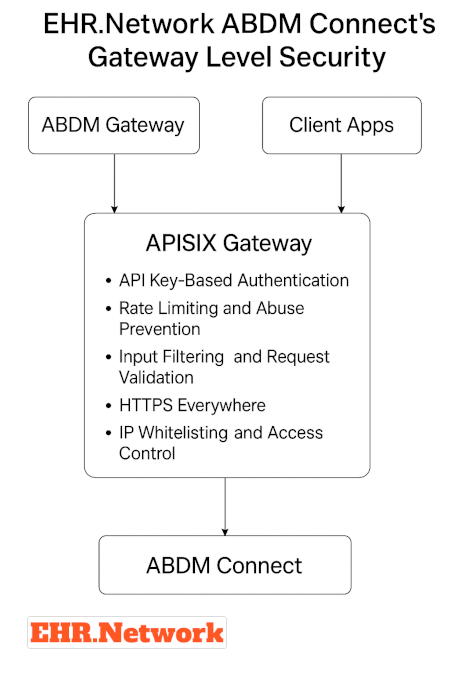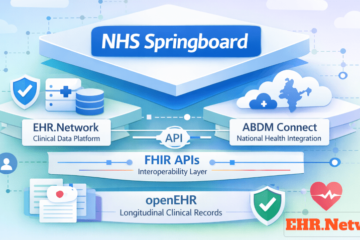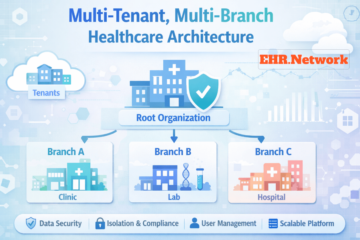Secure ABDM Integration: Gateway-Level Web Security with EHR.Network’s ABDM Connect

India’s Ayushman Bharat Digital Mission (ABDM) is redefining how health data is exchanged—securely, interoperably, and at national scale. As healthcare applications increasingly rely on secure ABDM integration to interact with patients, registries, and hospitals, implementing robust web security has become critical for compliance and patient protection.
At EHR.Network, security is a foundational principle. Our ABDM Connect platform enables healthcare providers to achieve secure ABDM integration quickly, implementing comprehensive API security measures at the gateway level using Apache APISIX—with JWT validation & API key-based authentication at the core.
Why ABDM Integration Requires Strong Web Security
ABDM Connect facilitates ABDM integration across sensitive digital health workflows including:
- ABHA creation and verification
- Digital consent management
- HIP-HIU data exchange
Each workflow involves transmitting personally identifiable health data over the public internet. Without proper gateway-level protection, secure ABDM integration becomes vulnerable to:
- Unauthorized access
- Accidental exposure
- Credential misuse
- Denial-of-service (DoS) attacks
To ensure compliance with ABDM’s security guidelines and protect healthcare providers and patients, we enforce defensive security at the API edge—making secure ABDM integration the default.
Implementing Secure ABDM Integration at the Gateway
We use Apache APISIX as our API Gateway to inspect, control, and protect all traffic into and out of the platform. Here’s how we’ve architected security for ABDM integration:

🛡️ 1. WAF implementing OWASP CRS
A web Application Firewall that uses the OWASP Common Rule Set to inspect and filter all incoming requests
- Real-time threat monitoring
- Properly validate JSON payloads containing medical records
- Protect against API-specific attacks like parameter pollution
- Minimal latency impact on critical patient data exchanges
- Smart rule ordering for optimal performance
🔐 2. JWT Validation for Callback APIs
All callbacks from ABDM Gateway are authenticated using the JWT issued by ABDM:
- Requests must have JWT issued by ABDM
- APISIX fetches the public key from ABDM using the customer bridge credentials
- APISIX validates the JWT using the public key
- Requests with invalid or missing JWT are rejected at the gateway
This ensures that only call backs from ABDM are accepted.
🔐 3. API Key-Based Authentication
Every client pursuing ABDM integration receives a unique API key:
- Requests must include the API key in headers (apikey)
- APISIX validates the key using its built-in key-auth plugin
- Requests with invalid or missing keys are rejected at the gateway
This mechanism offers fast and effective access control for secure ABDM integration without complex token management.
🛡️ 4. Rate Limiting and Abuse Prevention
To protect ABDM integration from abuse and ensure fair usage, we implement:
- Per-client rate limits (e.g., requests per second or minute)
- Endpoint-specific controls—tighter limits on sensitive operations like consent or data fetch
- Dynamic throttling to prevent unintentional DoS from faulty clients
🔎 5. Input Filtering and Request Validation
We sanitize incoming traffic to maintain security of ABDM integration by:
- Allowing only approved HTTP methods
- Restricting maximum payload sizes
- Blocking malformed or suspicious inputs
This reduces injection attack risks and ensures clean traffic reaches downstream services.
🌐 6. HTTPS Everywhere
All ABDM integration traffic between clients and the gateway is:
- Encrypted with TLS 1.2+
- Terminated securely at APISIX
- Compliant with ABDM’s guidelines for encrypted data exchange
This ensures privacy and integrity for every ABDM integration transaction.
🧱 7. IP Whitelisting and Access Control
We maintain tight network controls for ABDM integration using APISIX’s ip-restriction plugin:
- Only approved IPs can access gateway endpoints
- Optional geo-fencing or organization-specific IP rules
- Prevents unauthorized systems from compromising secure ABDM integration
🌍 8. Cross-Origin Resource Sharing (CORS)
Web-based health applications need secure browser access for secure ABDM integration. We implement strict CORS policies using APISIX’s cors plugin:
- Whitelist only approved domains for cross-origin requests
- Allow specific HTTP methods and headers (including x-api-key)
- Control credential transmission in browser environments
- Optimize preflight responses for better performance
This ensures legitimate web applications can achieve secure ABDM integration while blocking unauthorized cross-origin requests.
⚙️ 9. Modular and Extensible Architecture
Using APISIX’s flexible plugin system, we’ve built a modular security framework that supports secure ABDM integration through:
- Easy onboarding of new clients with their own keys and rules
- Tenant-specific policy enforcement
- Integration of custom logic without compromising core performance
Built for Secure ABDM Integration by Design
ABDM Connect is not just an integration layer—it’s a security-focused interface designed specifically for integration with India’s national digital health ecosystem. By handling security at the API gateway layer, we ensure that:
- Only trusted, verified clients can access ABDM services
- All traffic is filtered and controlled at the edge
- Security is uniform, consistent, and centrally managed
This architecture simplifies compliance and lets health app developers focus on functionality while we handle the complexities of ABDM integration.
Ready to Implement ABDM Integration?
With EHR.Network’s ABDM Connect, you don’t just get easy access to ABDM—you get comprehensive secure ABDM integration with peace of mind that your API traffic is protected, compliant, and controlled from day one.
Looking to implement secure ABDM integration for your healthcare application?
🔗 Learn more at ehr.network
📝 Get our help
📅 Book a call to discuss more



0 Comments